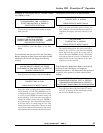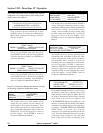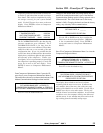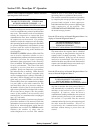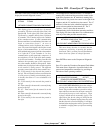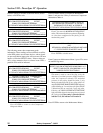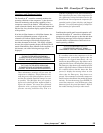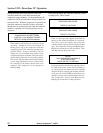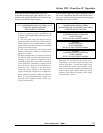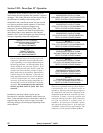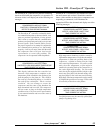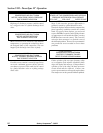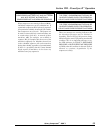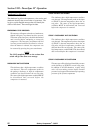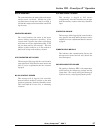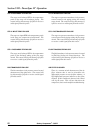
Section VIII - Power$ync II
™
Operation
Quincy Compressor
®
- QSD™ 61
If the controller detects temperatures above the
acceptable operating range of the compressor, it will
illuminate the appropriate LED on the schematic and
display one of the following messages:
NOTICE!
****** COMPRESSOR HAS SHUT DOWN ******
**NOTICE** MOTOR OVERLOAD
TAKE CORRECTIVE ACTION
If there is a motor overload, the LED on the
schematic will be illuminated and this message will
be displayed.
A) On air-cooled units, this message will be
displayed if either the main drive motor or the fan
motor experiences an overload shutdown. Open
the main electrical control enclosure to determine
which overload has tripped.
B) On water-cooled units, this message will
indicate a main motor overload or package vent
fan motor overload.
The most common cause of a tripped overload is
low voltage. If the overload trips while the unit is
starting, it may indicate insufficient power
available to the facility or incorrectly sized wiring
to the compressor. Intermittent tripping may be
the result of low voltage caused by variations in
incoming power supplies or by other large
horsepower motors starting on the same power
supply. Intermittent voltage drops are difficult to
detect without a recording voltmeter or a Dranitz
meter. If it is determined that low voltage is not
the cause of the tripped overload, contact your
service representative.
If the controller signals the starter to engage and it does
not receive confirmation that the starter contacts have
closed, one of the following messages will be displayed
depending on the type of starter:
NOTICE!
COMPRESSOR HAS SHUT DOWN
MAIN CONTACTOR AUX CONTACTS ARE OPEN
POSSIBLE FAILURE TO CLOSE
NOTICE!
COMPRESSOR WYE CONTACTOR
IS NOT CLOSING
REFER TO YOUR SERVICE MANUAL
NOTICE!
REMOTE STARTER
IS NOT ENGAGING
REFER TO YOUR SERVICE MANUAL
NOTICE!
COMPRESSOR WYE CONTACTOR
IS NOT OPENING
REFER TO YOUR SERVICE MANUAL
Determine the reason that the starter is not
responding, correct the problem and repeat the
start-up procedure. As with other faults, loose
wiring should be the first item checked. If all
wiring to and from the controller is tight and wiring
to the starter is tight, a faulty starter may be the
problem. If the starter is engaged, check wiring
to the auxiliary contacts.



